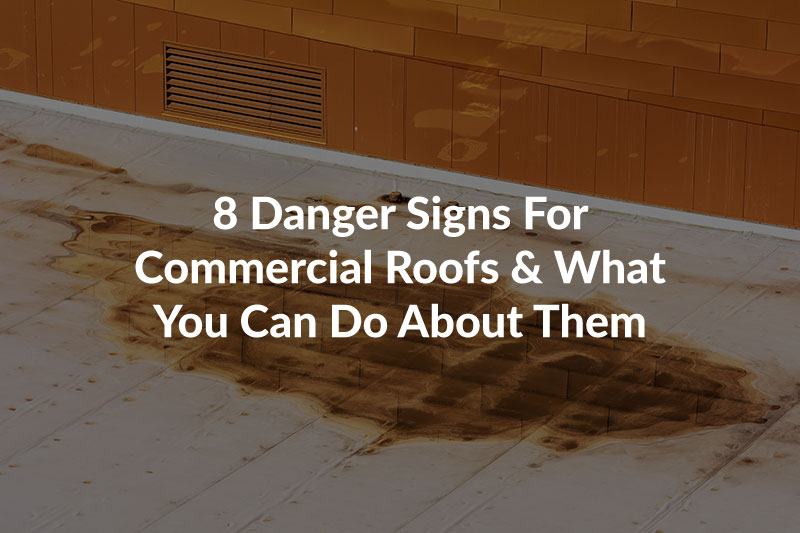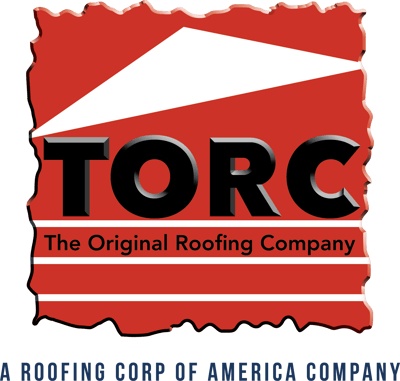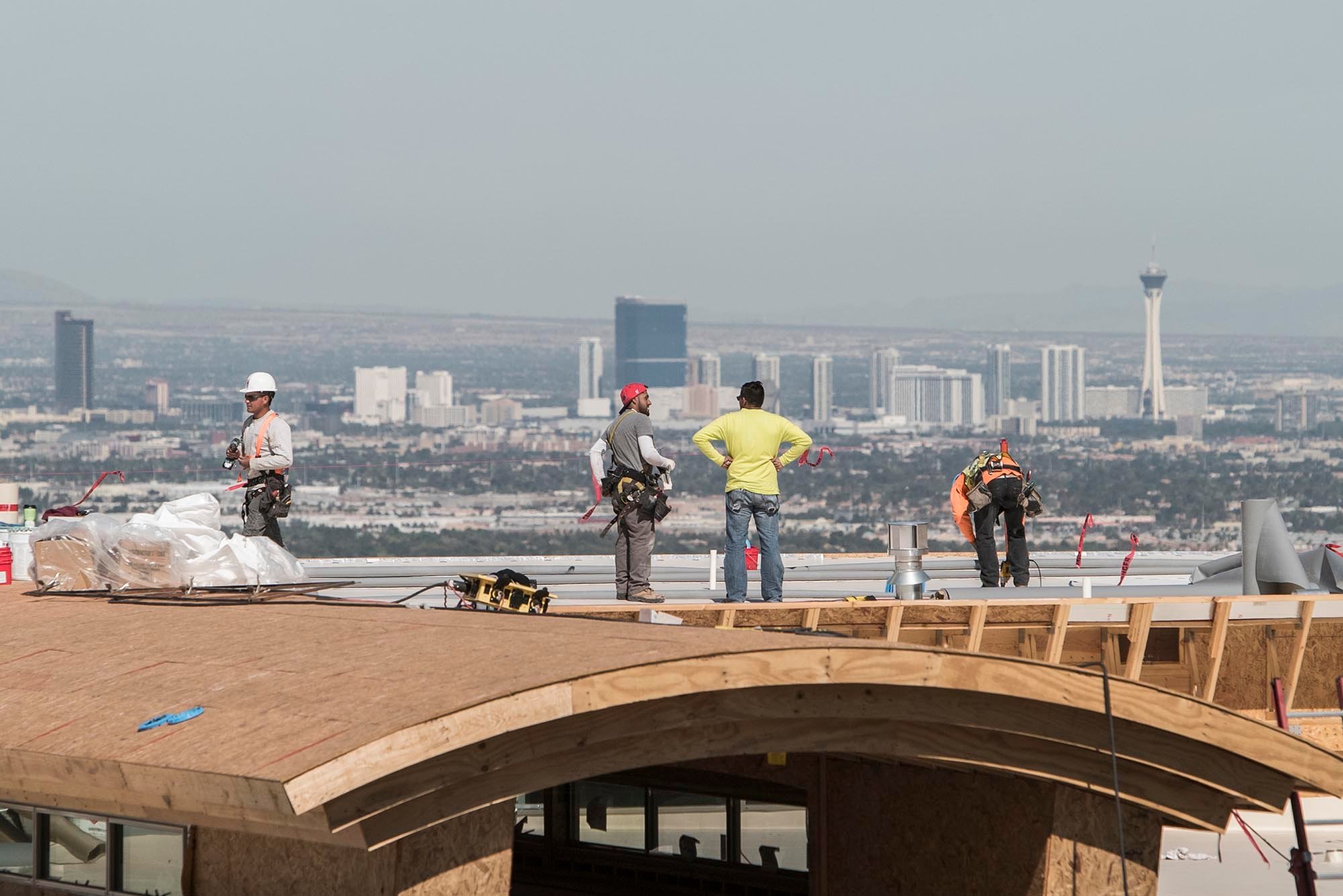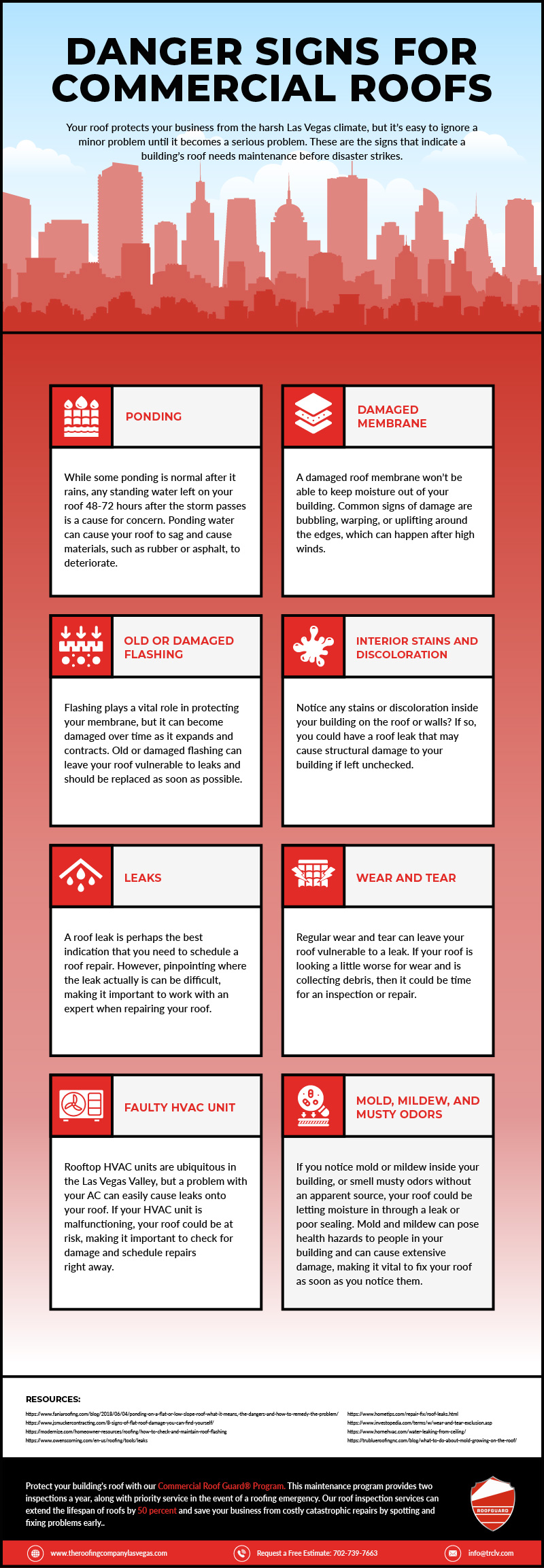
Whether you’re a business owner, facility director, or building engineer, you may take your building’s roof for granted. As long as the roof looks fine, everything is OK, right?
Not so fast. Just because your roof appears to be intact doesn’t mean it’s not compromised. The extreme heat, wind, and rain in Las Vegas can cause dangerous and costly damage that can sometimes be overlooked. So, since you’re not a roofing expert, what red flags should you look for and what do you do when you notice them?
Keep reading to learn the answers and download our helpful infographic about the subject.
8 Danger Signs For Commercial Roofs
Your commercial roofing system is crucial to the health and safety of its occupants, the integrity of the building, and the building’s appearance and value. When the roof gets damaged, it is not only unsightly but may create expensive (and embarrassing) problems for your building. Below are eight danger signs for commercial roofs:
Ponding
Ponding may occur after heavy rain. When water remains after 72 hours, there is a risk of water damage. Inadequate drainage systems, clogged drains, poor design, damaged roof insulation, and sagging are common causes of ponding. Water damage from ponding can lead to mold and mildew inside the building, and can also cause cracks, leaks, and sagging of the roof.
What you can do:
Take immediate action when you see ponding. While you wait for a professional local roofing contractor to inspect the roof, try to remove as much of the standing water as possible. Then, check the roof’s drainage system for clogs and flush it out.
Why you need to call an expert:
A roofer will correctly assess and repair the issue to prevent it from happening again. A roofing expert will do several different things to solve the ponding issue, which may include adding additional drains, fixing damaged insulation or membrane, fixing low spots, or re-pitching the roof.
Damaged Membrane
Flat commercial roofs have membranes to keep water from entering the building. While membranes are heat-resistant and waterproof, their thinness is prone to ripping. Strong winds can also detach the membrane from the roof.
Excessive foot traffic, animals and birds, tree branches, and debris can damage the membrane. Over time, blistering, cracking, or bubbles of air and moisture can appear within membrane layers. A damaged membrane will no longer keep water from coming inside your building.
What you can do:
Since a flat roof is prone to leaks and water damage, it is important to promptly address membrane issues. A biannual inspection by a licensed roofing professional can help prevent membrane damage. Trimming away overhanging tree branches, clearing debris, and limiting foot traffic are some steps to take while waiting for a professional to repair your damaged membrane.
Why you need to call an expert:
When a roofing professional repairs your roof membrane, they will remove debris and caulk around the tear and apply primer. They will then use a rubber patch to cover the hole or tear. Only a roofing professional can provide a comprehensive assessment of the roof membrane and make the correct repairs.
Old or Damaged Flashing
The flashing is the metal that surrounds the perimeter of the roof. Flashing prevents leaks and seals pipes, joints, and other components susceptible to moisture. Over time, exposure to extreme heat, strong wind, and heavy rain can bend, rust, crack, warp the flashing. If left untreated, the water damage can snowball and lead to costly roof repairs. If the flashing is too compromised, you may need a new roof.
What you can do:
You can repair minor flashing tears. You’ll need to plug any holes with roofing cement and a small patch of flashing material. Use sandpaper to roughen the area with the hole and affix the patching to the flashing using roofing cement. Cover the patch with more roofing cement.
Why you need to call an expert:
Flashing can be subjected to high amounts of running water. If not done correctly, water can seep into the roof membrane and the interior of the building. Repairing old or heavily damaged flashing is tedious and can be complicated.
A roofer will remove old molding and caulking around the flashing using special roofing cement. After the new flashing is placed, roofing cement is used to rejoin the roofing material to the flashing.
Interior Stains and Discoloration
Not all commercial roofing issues are visible on the outside. Stains and discoloration on the inside of your building are signs of a damaged roof. These ugly stains are often indicators of leaks and cracks. If not promptly treated, the roof can be further compromised, entailing extensive repairs. Additionally, mold can form, putting the health of the building’s occupants at risk. Some interior stains are the result of dirt and smoke accumulation caused by dirty air filters or faulty HVAC systems.
What you can do:
Identifying the cause of the stains and discoloration is the first step in solving this problem. Look at your pipes, AC, and HVAC systems for leaks. Condensation from a loose connection between a roof cap and exhaust and poor water quality can also contribute to water leaks. If there are small leaks, you can patch and tighten any loose fittings or pipes.
Why you need to call an expert:
Roof leaks are caused by damaged flashing and cracks in the roof and membrane. These repairs require a professional. A roofing company will diagnose the cause of the leak and fix it for good.
Leaks
A leaky roof requires immediate attention. When your roof leaks, the structural integrity of the building is compromised, putting tenant safety at risk. Leaks can cause mold and mildew to form inside the building.
There are many causes of roof leaks: loose flashing, a torn membrane, cracks in the roof, pooling, broken or leaking pipes, a faulty HVAC system, and wear and tear. Water leaks require the immediate attention of a roofing professional. If left untreated, leaks can worsen and entail costly, lengthy repairs, and may even result in the temporary closure of your building.
What you can do:
You can take preventative measures to reduce leaks, such as clearing away ponding, removing debris, and checking pipes and HVAC connections.
Why you need to call an expert:
Water leaks worsen if they aren't quickly treated by a roofing professional. An expert can identify the source of the leak and fix it.
Wear and Tear
Though commercial roofs can last 30 years, constant exposure to the sun, heat, wind, and debris can reduce their lifespan. Cracks, leaks, loose flashing, or damaged membranes can compromise the building’s structural safety and reduce its ability to keep water out.
What you can do:
The best thing you can do is to regularly check the roof for cracks, ponding, debris accumulation, and damaged flashing and membrane. If you notice something wrong, call a roofing expert. If your roof is nearing the end of its life, it may be more cost-effective to replace it. It’s an even better idea to schedule routine roof maintenance to ensure your roof is healthy year-round.
Why you need to call an expert:
You need your roof to be in good working order to keep tenants safe and comfortable. A professional roofer will conduct a thorough examination of your roof and catch issues you might have missed. They can also provide you with cost estimates and feedback as to whether you should repair the roof or install a new roof.
Faulty HVAC Unit
Proper insulation is needed to keep your building running efficiently and keep your energy bill low. Your roof plays an important role in maintaining a constant temperature inside the building. The HVAC may work harder if there are cracks in the walls, roof, and around windows and doors. If your HVAC system is faulty, it can mean it is overworked and that the roof is compromised.
What you can do:
While you wait for a professional, you can do the following:
- Check and replace the HVAC filters
- Look for clogs in the supply and return vents
- If your unit is outdoors, be sure to clear away debris
- Turn the thermostat to the correct cooling or heating mode
- Switch out the thermostat batteries
- Turn on all switches, breakers, and disconnects
Why you need to call an expert:
A damaged HVAC system can lead to high energy bills and make it uncomfortable inside of your building. A roofing technician will look for leaks, electrical connection issues, and thermostat efficiency.
Mold, Mildew, and Musty Odors
Mold, mildew, and musty odors are never good signs. They mean that moisture has found a way in through the roof and walls. Mold poses a health concern for your employees and customers. Mildew and musty odors are unpleasant to look at and smell.
What you can do:
Mold, mildew, and musty odors require immediate attention. You can remove the odors by locating the source. Check and seal all HVAC duct joints, replace wallcoverings, install additional fans, and clean the humidifier reservoir and condensation pan under the AC unit. While you can remove the mold, mildew, and unsightly stains caused by water leaks in the roof, you will need a professional roofer to fix the problem.
Why you need to call an expert:
A licensed roofing professional will perform a thorough inspection, pinpointing the cause of the mold and mildew. Additionally, they can repair leaky flashings and install cement backer boards behind the drywall.
Download the infographic by clicking here.
Maximize The Lifespan of Your Roof With Our Commercial Roof Guard® Maintenance Program
The roof of your building needs regular maintenance to ensure its effectiveness and maximize its lifespan. Over time, exposure to the elements will weaken the roof’s integrity and leave your building vulnerable.
Our Commercial Roof Guard® Program is a great way to extend the life of your roof. It includes twice-a-year roof inspections and gives you priority service should a roof emergency arise. This program is ideal for busy professionals like yourself who care about their employees, tenants, and customers inside the building.
The services in this program include:
- Debris removal
- Clearing all drains and downspouts
- The repair of small and potential roof leaks
- Adhesion checks of the fasteners
- The refastening of any loose materials or fittings
- Looking for cracks, seam separation, or blisters
- The inspection, refastening, and sealing of wall flashing
- The checking and resealing of vents, AC systems, and plumbing
- The inspection of solar heaters, solar panels, antennas, and satellite dishes
- A timeline and budget estimate for repairs
Many business and facility owners and managers have seen the benefits of the Commercial Roof Guard® Program, which can extend the life of your roof by 50%. Extending the life of your roof means you’ll enjoy a safe building for many years. Other benefits include:
- A protected roof and structure
- Early prevention of roof issues
- A more efficient building
- A stable and safe building
- A lower risk of interior health dangers and damage
- Peace of mind from heat and wind and rain storms
- Healthier air inside the building
- An increase in your building’s value
- Offers you priority appointments and emergency service from professional technicians
The Las Vegas Valley's Most Trusted Roofing Company
It's easy to take your roofing system for granted. While commercial roofing maintenance may be the last thing on your mind, it must stay in great shape. Small cracks, tears, and leaks can quickly turn into big problems that compromise building safety. Regardless of how big or small your roofing issue is, it is always best to call your local commercial roofing services company. If your roofing system is nearing the end of its useful life, it may be worthwhile to replace it. If you’re uncertain about your roof's lifespan, take the “Where Is Your Roof In Its Life Cycle?” quiz found on this page.





